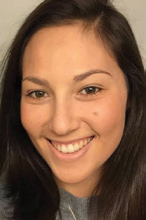Providing Perspective Through My ADHD Story
 My earliest school-related memory is from kindergarten. My teacher would assign a small homework packet on Monday that was due on the Friday of each week. Little did I know that my approach to completing my work was a unique one compared to the rest of my five-year-old peers. It took me years to understand this.
My earliest school-related memory is from kindergarten. My teacher would assign a small homework packet on Monday that was due on the Friday of each week. Little did I know that my approach to completing my work was a unique one compared to the rest of my five-year-old peers. It took me years to understand this.
I loved everything about school, except for the dreaded, gut-wrenching feeling that always seemed to creep up from the bottom of my stomach through my throat on Monday afternoons. On every step of the mile-long walk home from school, I couldn’t get the question out of my head: “How am I going to finish all of this work before dinner tonight?” Yes, I knew the packet was due on Friday and not the next day, but there was a suffocating feeling that I couldn’t shake until every single piece of homework for the week was checked off my list and neatly tucked back into my folder.
One week our homework was to create an alphabet book. I’m sure every reader knows exactly what I’m about to describe. Each page had a different letter, and we were supposed to cut out or illustrate images that started with that letter. A reasonable approach to this assignment would be to do six or seven letters a night for the next four nights, and then I’d be set to turn everything in on Friday, right on time. But this was simply not an option for me. The feeling of panic, which in the next several years became all too familiar, set in and propelled me forward at a hundred miles per hour. My rational thinking quickly went off the rails and my irrational, anxious brain took the driver’s seat and never bothered to look back.
My parents tried to explain there was no need to do all 26 letters in one night. I heard the words they were saying, but my brain wouldn’t let me process or accept this as an option. I just could not let the unfinished work lay there on the table. An hour-long tantrum of screaming and crying ensued on the corner of the stairs leading to my bedroom. This was a weekly occurrence. Ultimately, I stayed up way too late for a five-year-old, but I finished my A-to-Z book and turned it into my teacher on Tuesday, feeling a great sense of pride.
Fast-forward to about age eight. I remember walking our greyhound, Chief, down our street with my dad, when he said something really weird: “Hey, Mal, you’re going to start to take some medication.” Sure, I knew what medication was, but I didn’t understand why I needed it to help me. I was a strong student who was performing above grade level, and I loved going to school every day. I had plenty of friends and was always the star on the sports team. In my eyes, I was living a pretty normal life.
After testing and speaking to a doctor, I was formally diagnosed with ADHD and an anxiety disorder. This did not really change anything for me, as feeling this way was normal for me; it was all I knew. I thought everyone felt like this, but as I got older, I realized that my friends didn’t feel this constant mounting of anxiety and worry.
These anxious and paranoid feelings of urgency and panic to complete my work kept me in a holding pattern for the next several years of school. I knew I didn’t want to feel like this, but I simply didn’t know what to do, nor did I think it was possible to live any other way. It wasn’t until 2019, when I began my master’s program at Johns Hopkins University, that I began to understand why I am the way I am and how the wiring of my brain affects my day-to-day life experiences.
A large part of my studying encompassed the integration of mind, brain, and learning. The intimate connection of cognition and emotion was eye-opening for me. We read articles and studies where I literally thought the data and results were describing me.
Near the end of my studies for my master’s degree, I began working at Essig Education Group as an executive function coach, working with middle and high school students. These students have helped me begin to cope with my ADHD and anxiety in ways I didn’t think possible. Speaking with parents about working memory overload, attention, and anxiety through my personal lens helped me realize that I am normal; I just have to do things differently to find success. Success takes shape in numerous ways; we must figure out how to create and find our own forms of success. It’s okay that my path to success looks different from the paths of my peers.
Although I have always been a straight-A student who works diligently and with great resilience, I have low self-confidence in my abilities. I often feel as though I have imposter syndrome, like I am not worthy and that I don’t belong, even though I have the appropriate qualifications. Despite growing up with two loving parents who were extremely well-versed in the special-education world, I still struggled deeply with feeling like I was incapable of meeting the standards I envisioned people set for me.
What I wish for all children growing up with ADHD, anxiety, or any learning difference is that they understand that they are not alone. Loneliness and shame are emotions that perpetuate alienation. Having transparent conversations with children about how their brains are wired is a key component to ensuring that students can begin to see their value and their positive attributes, especially during their early school years.
My experience parallels how many of my students feel. Part of the reason I am so passionate about working with them is because I see pieces of myself in all of them. I hope that I provide them with the mentorship and guidance I wish I had at their age. My goal is to help students think metacognitively about themselves and their learning, and to normalize and destigmatize negative connotations about their diagnoses. If students can understand why they function and behave as they do, they can begin to accept themselves for who they are and take advantage of strategies to make life easier than it currently is. Yes, we may have to work harder and differently than our peers, but these diagnoses make us unique.
I have come to accept that my ADHD and anxiety are just another part of who I am, but they are not all that I am. I do not let them set my limitations for me. I am not sure who I would be or where I would be if I didn’t have ADHD or anxiety, but I do know that I’ve learned how to be the hardest working person in the room and how to advocate for myself. I hope I can help unleash these passions for my students as well. ADHD and anxiety are my invisible superpowers that directly launch me into my students’ worlds.
I share my story with my students in the hope that they can begin to understand how valued they truly are. Growing up, I never knew there were others who struggled the ways I did; nor did I know other people felt like they were living in a different universe than their peers. I wish someone had told me that I was not alone. Being able to connect with my students on such a personal level at such young ages helps create perspective for them.
My goal is to use my story to illustrate that learning disabilities are labels, but don’t have to be more than that if you don’t let them take that power away from you. Despite the way my brain is wired, and the heightened feelings of anxiety I experience daily, I have learned how to be successful and independent. Diagnoses do not define who we are nor how successful we will become.
What I wish for all young children is what I wished for my younger self: for someone to sit down with me and look me directly in the eyes and tell me that everything is going to be okay. Life is going to present you challenges and you’ll learn how to navigate through them. You will be successful in whatever you choose to pursue, not despite your diagnosis, but because of it. You are going to change the world one day. You matter. Your voice matters. Understanding your brain and your temperament matters.
We get our message across to children by having open dialogues with them and helping them comprehend how ADHD affects their life. We tell them that we are on their team and will do any and everything we can to help them find their way. We can help our children learn resilience by providing them with the appropriate tools and information they need to be successful. Be present for your child and deeply listen to what they are sharing with you through their words and actions.
I share my story with my students because I was them. I am them. They are not alone. They are not weird. They are enough; in fact, they are more than enough. My story is never going to be completely finished, but I have the opportunity to use it to empower young children to begin to understand their value and importance in the world.


 Mallory Band, MSEd, an executive function coach with the Essig Education Group, has worked in the field of education and special education since 2014. She is thrilled to share her knowledge, enthusiasm, and passion to help children gain independence and confidence in themselves.
Mallory Band, MSEd, an executive function coach with the Essig Education Group, has worked in the field of education and special education since 2014. She is thrilled to share her knowledge, enthusiasm, and passion to help children gain independence and confidence in themselves.